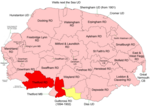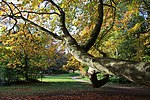Santon Downham
Civil parishes in SuffolkForest HeathVillages in Suffolk

Santon Downham is a village and civil parish in the West Suffolk district of Suffolk in eastern England. In 2005 it had a population of 240. The village is located within Thetford Forest on a meander of the River Little Ouse on the Norfolk-Suffolk border. Thetford is 4 miles (6 km) southeast and the nearest railway station is in Brandon 2 miles (3 km) west.
Excerpt from the Wikipedia article Santon Downham (License: CC BY-SA 3.0, Authors, Images).Santon Downham
West Suffolk
Geographical coordinates (GPS) Address Nearby Places Show on map
Geographical coordinates (GPS)
| Latitude | Longitude |
|---|---|
| N 52.456611 ° | E 0.667891 ° |
Address
IP27 0WB West Suffolk
England, United Kingdom
Open on Google Maps









